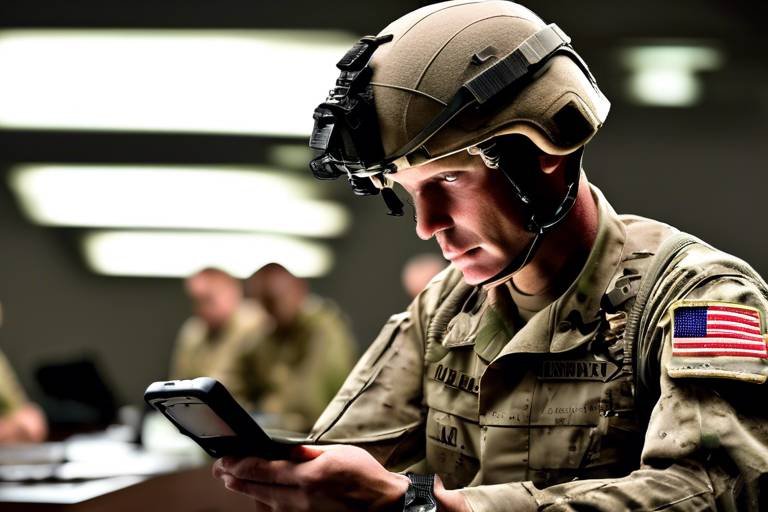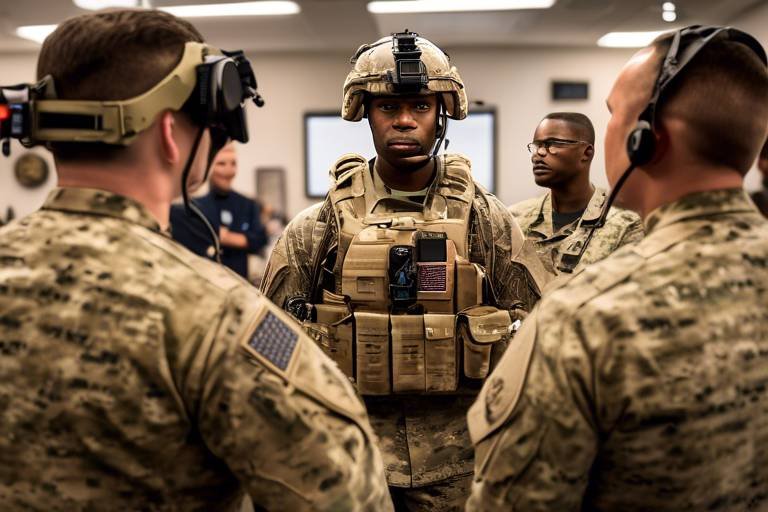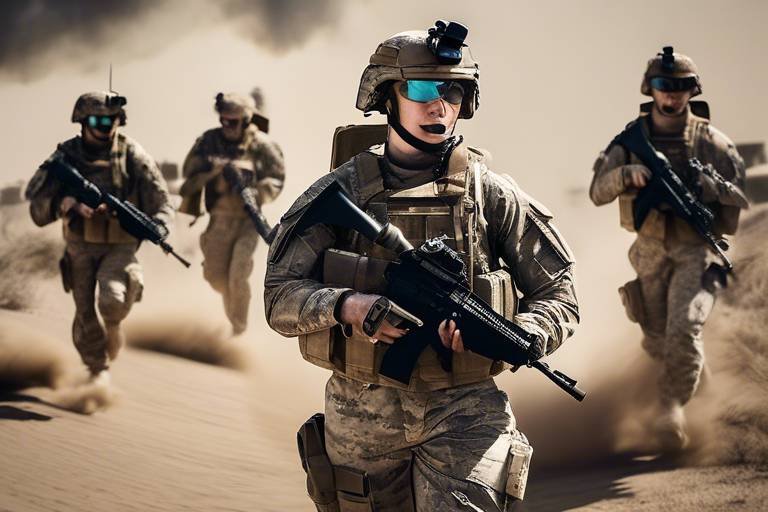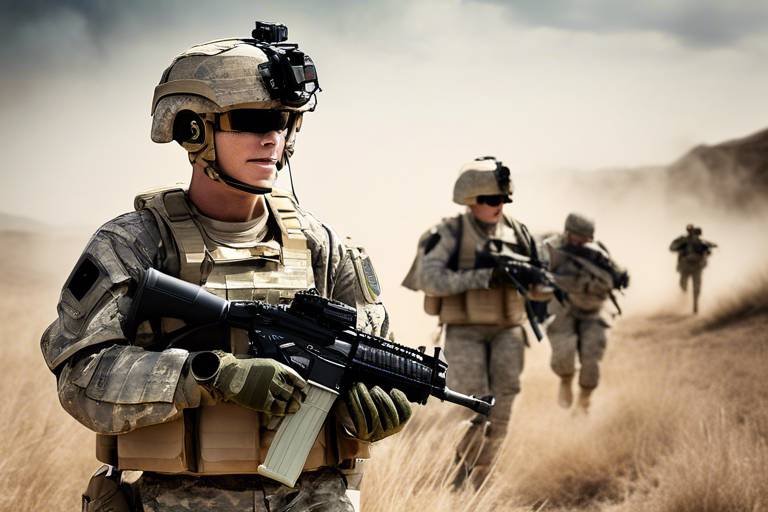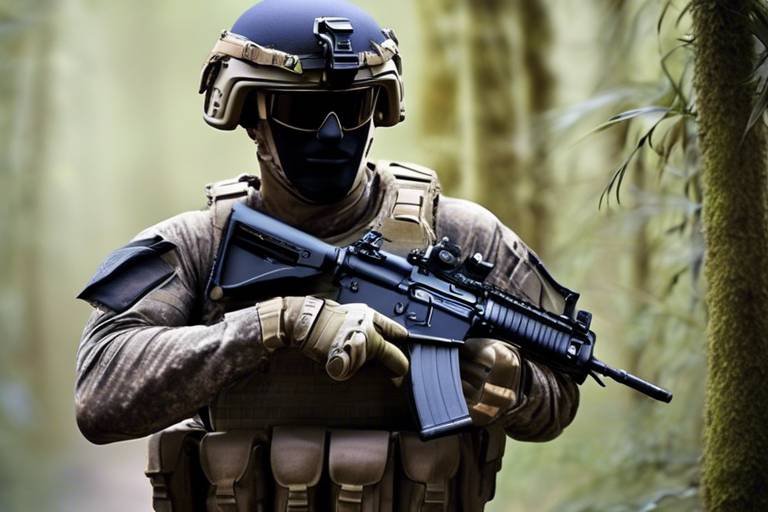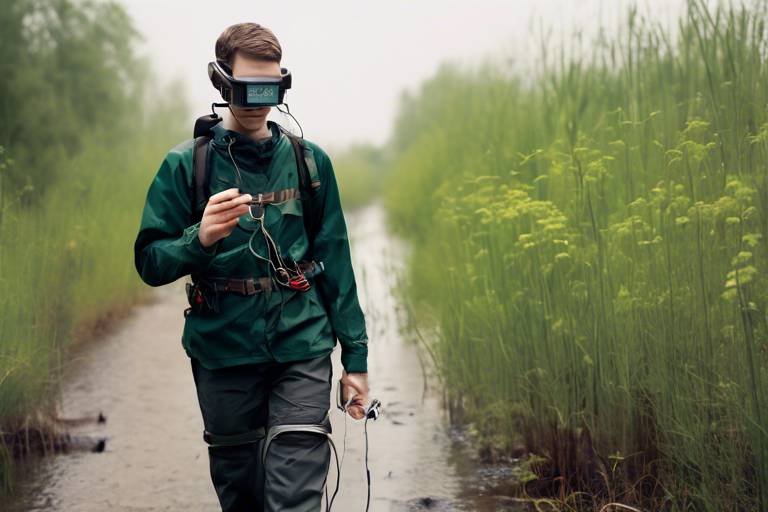The Use of Wearable Tech in Urban Search and Rescue
In today's fast-paced world, the integration of wearable technology in urban search and rescue (USAR) operations is nothing short of revolutionary. Imagine a scenario where rescuers are equipped with smart devices that not only keep track of their health but also provide real-time data about their surroundings. This isn't just science fiction; it's a reality that's rapidly evolving. Wearable tech has the potential to transform how emergency responders operate, making their missions safer and more efficient. But what exactly does this technology entail, and how is it being utilized in the field?
Wearable technology includes a variety of devices that can be worn on the body, such as smartwatches, fitness trackers, and specialized sensors. These devices are engineered to collect and transmit data in real-time, allowing teams to communicate effectively and make informed decisions quickly. For instance, a smartwatch could monitor a rescuer's heart rate while also providing GPS coordinates, ensuring that both the individual and the team remain aware of their status and location. The use of such technology not only enhances operational efficiency but also boosts the safety of the personnel involved.
The benefits of wearable tech in rescue operations are numerous and impactful. One of the most significant advantages is the improved situational awareness that these devices provide. In chaotic environments, such as collapsed buildings or disaster zones, knowing exactly where team members are located and their physical condition can be the difference between life and death. Wearable devices equipped with GPS tracking capabilities allow for precise location tracking, which is crucial in urban settings where traditional navigation might be hindered by debris or other obstacles.
Moreover, health monitoring features embedded in these devices can track vital signs and alert team leaders if someone is in distress. This capability ensures that immediate medical attention can be provided when necessary, ultimately saving lives. The data collected from these wearables can also be analyzed post-operation to improve future missions, creating a cycle of continuous improvement in rescue strategies. However, while the advantages are clear, the integration of such technology is not without its challenges.
One significant hurdle is the reliability of the technology itself. In high-stress situations, devices must function flawlessly, and any malfunction could jeopardize a rescue mission. Additionally, proper training is essential to ensure that all team members can effectively use the technology at their disposal. Data security is another critical concern; as with any connected device, the risk of unauthorized access to sensitive information is a reality that must be addressed.
Looking ahead, the future of wearable tech in urban search and rescue is bright and filled with potential. Innovations in artificial intelligence (AI) and machine learning are set to revolutionize how data from wearables is utilized. Imagine AI systems analyzing real-time data to predict potential hazards or identify the most efficient routes for rescuers. Such advancements could dramatically enhance decision-making processes during emergencies.
Furthermore, ongoing research and development in battery life and device durability will ensure that wearables can withstand the rigors of rescue operations. As technology continues to evolve, we can expect to see more robust devices that can operate longer and in more challenging environments, ultimately increasing their effectiveness in saving lives.
- What types of wearable technology are commonly used in urban search and rescue? Devices like smartwatches, health monitors, and GPS trackers are commonly utilized.
- How does wearable tech improve situational awareness? Wearable devices provide real-time data about the location and health of rescuers, allowing for better decision-making.
- What are some challenges faced when integrating wearable technology? Challenges include technology reliability, the need for adequate training, and concerns about data security.
- What future advancements can we expect in wearable tech for rescue operations? We can anticipate improvements in AI integration, battery life, and device durability.
Introduction to Wearable Technology
Wearable technology is revolutionizing the way we approach various fields, and urban search and rescue (USAR) is no exception. These innovative devices, designed to be worn on the body, serve a multitude of purposes ranging from tracking vital signs to enhancing communication among rescue teams. Imagine a world where rescuers can instantly access crucial information about their environment and the health of their team members while navigating through chaotic urban landscapes. This is not just a dream; it's the reality that wearable technology is bringing to the forefront of emergency response.
At its core, wearable technology in rescue operations includes a variety of devices such as smartwatches, body cameras, and health-monitoring sensors. Each of these devices plays a pivotal role in ensuring that rescuers are better equipped to handle the demanding situations they encounter. For instance, smartwatches can provide real-time notifications and alerts, while body cameras document the rescue process for later analysis and training. The integration of these technologies not only enhances safety but also improves the overall effectiveness of rescue missions.
To further illustrate the types of wearable technology utilized in urban search and rescue, consider the following categories:
- GPS-enabled devices: These wearables allow for precise location tracking, helping teams coordinate their efforts and locate victims swiftly.
- Health monitoring wearables: Equipped with sensors, these devices track vital signs such as heart rate and oxygen levels, providing critical data about the health of both rescuers and victims.
- Communication tools: Devices that facilitate seamless communication among team members, ensuring that information is shared quickly and efficiently.
As we delve deeper into the benefits and challenges of wearable technology in rescue operations, it becomes clear that this advancement is not just about convenience; it’s about saving lives. The ability to collect and analyze data in real-time can mean the difference between a successful rescue and a tragic outcome. In the following sections, we'll explore how these devices are transforming urban search and rescue and the potential hurdles that come with their implementation.
Benefits of Wearable Tech in Rescue Operations
When it comes to urban search and rescue operations, the integration of wearable technology is nothing short of a game changer. Imagine a world where rescuers are equipped with devices that not only keep them connected but also provide real-time data to enhance their effectiveness in critical situations. This is precisely what wearable technology brings to the table. With features like GPS tracking, health monitoring, and real-time communication, these devices significantly improve situational awareness and operational efficiency.
One of the most compelling advantages of wearable tech is its ability to enhance communication. In high-pressure environments, clear communication is vital. Wearable devices can facilitate instant messaging and voice communication, allowing team members to share information rapidly without the need for cumbersome equipment. This is especially crucial when every second counts, such as during a building collapse or natural disaster. The ability to communicate seamlessly can mean the difference between life and death.
Moreover, the data analytics capabilities of these devices provide valuable insights that can help in planning and executing rescue missions. Wearables can collect and analyze data from various sensors, including environmental conditions and the physical state of the rescuers. For instance, if a rescuer is becoming fatigued or dehydrated, the wearable can alert the team, allowing for timely interventions. This not only protects the rescuers but also ensures that the mission continues smoothly.
Real-time data collection is at the heart of wearable technology's impact on rescue operations. The ability to gather critical information instantly can drastically influence decision-making processes. For example, a wearable device can provide real-time updates on a rescuer's location, heart rate, and even their oxygen levels. This data is crucial for assessing the situation and determining the best course of action.
One of the standout features of many wearable devices is their GPS tracking capabilities. In urban environments, where buildings can obstruct visibility and complicate navigation, having precise location tracking is invaluable. Wearable GPS technology allows rescue teams to coordinate their efforts effectively, ensuring that everyone is on the same page. It also aids in locating victims who may be trapped in hard-to-reach places, thereby speeding up the rescue process.
Another significant benefit of wearable technology in rescue operations is its health monitoring features. Many devices come equipped with sensors that track vital signs such as heart rate, body temperature, and even blood oxygen levels. This information can be crucial for assessing the condition of both the rescuers and the victims. For example, if a rescuer's heart rate spikes due to stress or exertion, the team can take immediate action to ensure their safety. Similarly, monitoring a victim's vital signs can provide essential information that guides medical interventions.
In summary, the benefits of wearable technology in urban search and rescue operations are profound. From enhancing communication and providing real-time data to monitoring health metrics and improving situational awareness, these devices are revolutionizing the way rescue missions are conducted. The integration of wearables not only increases the safety and efficiency of rescue teams but also enhances the overall effectiveness of urban search and rescue operations.
- What types of wearable technology are commonly used in rescue operations? Wearable technology includes devices like smart helmets, GPS trackers, and health monitoring wearables that help rescuers stay connected and informed.
- How does wearable tech improve communication among rescue teams? Wearable devices facilitate instant messaging and voice communication, enabling team members to share vital information quickly and efficiently.
- Can wearable devices track the health of both rescuers and victims? Yes, many wearable devices come equipped with sensors that monitor vital signs, helping assess the health of both rescuers and those they are trying to save.
- What challenges exist in implementing wearable technology in rescue operations? Challenges include technology reliability, the need for proper training, and concerns about data security.
Real-time Data Collection
In the high-stakes world of urban search and rescue, every second counts. Imagine a scenario where a building has collapsed, trapping individuals beneath the rubble. In such critical moments, becomes not just an advantage, but a lifeline. Wearable technology equips rescuers with the ability to gather essential information instantly, transforming how operations are conducted. With devices capable of tracking location, monitoring health metrics, and providing situational updates, the landscape of rescue missions is evolving rapidly.
One of the most remarkable features of wearable tech is its ability to collect vital signs and environmental data in real-time. For instance, rescuers can monitor heart rates, body temperatures, and even stress levels, which are crucial for assessing the physical condition of both the rescuers and the victims. This data is transmitted instantly to command centers, allowing for informed decision-making. As a result, teams can adjust their strategies based on the health status of individuals involved in the rescue.
Moreover, the integration of GPS technology into these wearables further enhances their functionality. GPS-enabled devices allow rescuers to pinpoint their exact location and navigate complex urban environments with ease. This capability not only aids in locating victims but also facilitates better coordination among different rescue teams. Imagine a rescue operation where multiple teams are deployed across a vast area; the ability to share real-time locations ensures that efforts are synchronized, minimizing the risk of overlapping searches and maximizing efficiency.
Furthermore, the data collected from wearables can be analyzed to identify patterns and trends. For example, if a particular area shows a high concentration of heart rate spikes among victims, it may indicate a more severe situation that requires immediate attention. This analytical capability is invaluable, as it allows rescue teams to prioritize their efforts based on the data at hand.
In summary, the role of real-time data collection in urban search and rescue operations cannot be overstated. The combination of health monitoring, GPS tracking, and data analytics creates a powerful toolkit for rescuers, enabling them to act swiftly and effectively in emergency situations. As technology continues to advance, we can expect even greater improvements in the way data is collected and utilized, ultimately leading to more successful rescue missions.
- What types of wearable technology are used in urban search and rescue? Wearable technology includes GPS trackers, health monitors, and communication devices that help rescuers gather data and coordinate efforts.
- How does real-time data collection improve rescue operations? It allows rescuers to make informed decisions quickly, ensuring that they can respond effectively to the needs of victims and the dynamics of the situation.
- Are there any challenges associated with using wearable tech in rescue missions? Yes, challenges include technology reliability, the need for proper training, and concerns about data security.
GPS Tracking Capabilities
The integration of in wearable technology has revolutionized the way urban search and rescue teams operate. Imagine being able to pinpoint the exact location of a rescuer or a victim in a chaotic urban landscape—this is precisely what GPS technology enables. In emergency situations, every second counts, and the ability to track individuals in real-time can be the difference between life and death.
Wearable devices equipped with GPS functionality allow rescue teams to maintain a clear line of sight on their personnel and the people they are trying to save. This ensures that coordination is seamless, reducing the chances of miscommunication or getting lost in the fray of an emergency. For instance, if a rescuer is trapped or in a precarious situation, their GPS-enabled device can relay their location to the command center, enabling quick action to be taken. This level of communication is not just beneficial; it's essential.
Furthermore, the data gathered through GPS tracking can be analyzed to improve future rescue operations. By reviewing the paths taken during previous missions, teams can identify patterns and trends, leading to enhanced strategies for future emergencies. It's akin to having a map of past battles, where you learn from every skirmish to come back stronger and more prepared.
In addition to tracking rescuers, GPS technology can also aid in locating victims. In urban environments, where buildings can obstruct signals and complicate searches, advanced GPS systems can provide accurate coordinates, helping teams to navigate efficiently. This is particularly useful in scenarios where victims may be trapped under debris or in hard-to-reach areas. The ability to overlay GPS data on maps can also assist in visualizing the search area, making it easier for teams to strategize their approach.
Here’s a brief overview of how GPS tracking capabilities enhance urban search and rescue operations:
| Feature | Benefit |
|---|---|
| Real-time Location Tracking | Allows immediate awareness of rescuers' and victims' locations. |
| Data Analysis | Improves future operational strategies through learned patterns. |
| Mapping Integration | Helps visualize search areas for better planning and execution. |
In summary, the of wearable technology are not just a luxury; they are a necessity in urban search and rescue missions. As technology continues to advance, we can expect even more sophisticated GPS systems that will further enhance the safety and efficiency of rescue operations. The future looks bright, and with the right tools, urban search and rescue teams can navigate the complexities of emergencies more effectively than ever before.
- How does GPS technology improve safety for rescuers?
GPS technology allows rescuers to be tracked in real-time, ensuring their safety by enabling quick response in case of emergencies. - Can GPS work in areas with poor signal?
While GPS can be less effective in densely built environments, advanced systems are being developed to improve accuracy even in challenging conditions. - What other technologies complement GPS in rescue operations?
Technologies such as drones, thermal imaging, and communication devices often work alongside GPS to enhance overall mission effectiveness.
Health Monitoring Features
In the high-stakes world of urban search and rescue, every second counts, and the ability to monitor health metrics in real time can make all the difference. Wearable technology has evolved to include sophisticated health monitoring features that are not just beneficial but essential for both rescuers and victims. Imagine a scenario where a rescuer is trapped under debris; having immediate access to their vital signs can help determine their condition and the urgency of the rescue. Wearable devices equipped with health sensors can track a range of metrics, including heart rate, respiratory rate, and body temperature.
These metrics provide critical insights into the physical state of rescuers during intense operations. For instance, if a rescuer's heart rate spikes significantly, it could indicate stress or exhaustion, prompting team leaders to rotate personnel or provide immediate medical assistance. Similarly, monitoring the vital signs of victims can help responders prioritize their actions based on the severity of their condition. This is particularly important in chaotic environments where every decision can have life-or-death consequences.
Moreover, the integration of health monitoring features into wearable tech allows for the collection of data that can be analyzed post-operation. By examining trends in vital signs, rescue teams can refine their strategies and improve training protocols for future missions. This data-driven approach not only enhances the effectiveness of current operations but also contributes to the overall safety and preparedness of rescue teams.
To illustrate the potential of health monitoring features in wearable tech, consider the following table that outlines key health metrics and their implications during rescue operations:
| Health Metric | Normal Range | Implications |
|---|---|---|
| Heart Rate | 60-100 bpm | A spike may indicate stress, while a drop could signal exhaustion or medical issues. |
| Respiratory Rate | 12-20 breaths per minute | Increased rates may suggest panic or respiratory distress. |
| Body Temperature | 97°F - 99°F | Elevated temperatures could indicate heat exhaustion or infection. |
As we look to the future, the potential for wearable technology to revolutionize health monitoring in rescue operations is immense. The convergence of health data with GPS tracking and other wearable features can create a comprehensive picture of the operational environment, ultimately leading to more effective and safer rescue missions. In the end, the integration of health monitoring features in wearable tech is not just about collecting data; it's about saving lives.
- What types of health metrics can wearable devices monitor?
Wearable devices can monitor vital signs such as heart rate, respiratory rate, body temperature, and even blood oxygen levels. - How do health monitoring features improve rescue operations?
They provide real-time data that helps assess the condition of rescuers and victims, enabling informed decision-making and prioritization of care. - Can wearable tech be used in extreme conditions?
Yes, many wearable devices are designed to be durable and functional in challenging environments, though ongoing advancements in battery life and durability are essential.
Challenges of Implementing Wearable Tech
While the integration of wearable technology in urban search and rescue operations comes with a plethora of advantages, it is not without its challenges. One of the most significant hurdles is technology reliability. In high-stress situations, such as emergency rescues, the last thing rescuers need is a malfunctioning device. Imagine being in the middle of a chaotic urban environment, relying on a gadget that suddenly fails. This could lead to critical delays and potentially jeopardize lives. Therefore, ensuring that wearable devices are robust and function flawlessly under duress is paramount.
Another challenge is training. Even the most advanced technology is only as effective as the users who operate it. Rescuers must be adequately trained not only to use the devices but also to understand the data they provide. This requires time and resources, which can be limited in emergency response scenarios. For instance, if a team receives new wearable tech just before a major operation, they may not have the opportunity to become proficient with it. As a result, the technology may not be utilized to its full potential, limiting its effectiveness during critical missions.
Moreover, there are substantial data security concerns associated with wearable technology. In an era where data breaches are becoming increasingly common, the sensitive information collected by these devices—such as health metrics and location data—must be protected. If hackers gain access to this information, it could compromise not only the safety of the rescuers but also the victims they are trying to save. As such, implementing robust cybersecurity measures is essential to ensure that the data remains secure and that the technology is trusted by all parties involved.
In summary, while wearable tech holds immense promise for enhancing urban search and rescue operations, the challenges of reliability, training, and data security cannot be overlooked. Addressing these issues is crucial for maximizing the potential of these innovative devices and ensuring that they can be relied upon in life-or-death situations.
- What types of wearable technology are used in urban search and rescue? Wearable technology in rescue operations includes GPS trackers, health monitors, and communication devices that provide real-time data to rescuers.
- How does wearable tech improve situational awareness? By providing real-time data and analytics, wearable devices enhance rescuers' understanding of their environment and the conditions of victims, allowing for better decision-making.
- What are the main concerns regarding data security in wearable tech? The primary concerns include potential data breaches and unauthorized access to sensitive information, which can jeopardize the safety of both rescuers and victims.
- How can training improve the effectiveness of wearable technology? Proper training ensures that rescuers are proficient in using the devices and interpreting the data, maximizing the technology's benefits during operations.
Future Trends in Wearable Tech for Rescue
As we look ahead, the landscape of wearable technology in urban search and rescue operations is poised for remarkable transformation. The integration of advanced technologies like artificial intelligence (AI) and machine learning is set to revolutionize how rescuers operate in emergencies. Imagine a world where wearable devices not only track location but also analyze data in real-time to provide actionable insights. This synergy between AI and wearables can significantly enhance decision-making processes, allowing teams to respond more effectively and efficiently in critical situations.
One of the most exciting prospects is the ability of AI to process vast amounts of data collected from multiple sources simultaneously. For instance, wearables can monitor environmental conditions, track vital signs, and even detect hazardous materials. By utilizing machine learning algorithms, these devices can learn from past incidents and improve their predictive capabilities, thus increasing the chances of successful rescues. The potential for AI to assist in identifying patterns and anomalies in data can lead to quicker, more informed decisions, ultimately saving lives.
Additionally, advancements in battery life and durability are crucial for the future of wearable tech in rescue missions. Rescuers often operate in challenging environments where access to power sources is limited. Thus, the development of long-lasting batteries that can withstand extreme conditions is essential. Innovations in battery technology, such as solid-state batteries and energy harvesting systems, are already being explored. These advancements promise to extend the operational time of wearables, ensuring that rescuers remain connected and equipped throughout their missions.
Furthermore, the durability of wearable devices is paramount. Rescuers face unpredictable environments, from rubble-strewn disaster sites to extreme weather conditions. Future wearables must be rugged, waterproof, and capable of withstanding shocks and impacts. Manufacturers are increasingly focusing on creating devices that meet these demands, ensuring that technology can keep up with the rigorous requirements of rescue operations. This focus on durability will not only enhance the reliability of the devices but also boost the confidence of rescuers who depend on them.
In summary, the future of wearable technology in urban search and rescue is bright and filled with possibilities. With the integration of AI, improvements in battery life, and enhancements in durability, these devices are set to become indispensable tools for rescuers. As we continue to innovate and adapt, the potential for wearable tech to save lives and improve operational efficiency is limitless.
- What types of wearable technology are currently used in rescue operations? Wearable technology in rescue operations includes smart helmets, GPS trackers, health monitoring devices, and communication tools.
- How does AI improve decision-making in rescue missions? AI analyzes real-time data from wearables to identify patterns, predict outcomes, and provide actionable insights for rescuers.
- What challenges do rescuers face when using wearable technology? Challenges include technology reliability, the need for extensive training, and concerns about data security.
- What advancements are being made in battery technology for wearables? Innovations such as solid-state batteries and energy harvesting systems are being explored to enhance battery life and performance in challenging environments.
Integration with AI and Machine Learning
Imagine a world where rescue operations are not just reactive but proactive, where technology works hand-in-hand with human intuition to save lives. This is the promise of artificial intelligence (AI) and machine learning in urban search and rescue (USAR) missions. By integrating these advanced technologies with wearable devices, we can revolutionize how rescuers operate, making them more efficient and effective in high-pressure situations.
At the core of this integration is the ability of AI to analyze large datasets in real-time. Wearable tech collects a wealth of information, from GPS coordinates to health metrics, and AI can sift through this data to identify patterns and make predictions. For example, if a rescuer's vital signs indicate extreme fatigue or stress, AI algorithms can alert team leaders to reassign tasks or provide additional support. This capability not only enhances the safety of the rescuers but also optimizes the overall efficiency of the operation.
Moreover, machine learning can improve over time. As these systems gather more data from various rescue missions, they become better at predicting outcomes and suggesting best practices. Imagine a scenario where a team is dispatched to a collapsed building. AI could analyze previous incidents in similar environments and recommend strategies that have proven successful in the past. This kind of data-driven decision-making can significantly reduce the time it takes to locate victims and ensure their safety.
To illustrate the potential of AI integration, consider the following table that outlines some key benefits:
| Benefit | Description |
|---|---|
| Enhanced Decision-Making | AI analyzes real-time data to provide actionable insights, improving the speed and accuracy of decisions made by rescue teams. |
| Predictive Analysis | Machine learning algorithms can predict potential hazards and outcomes based on historical data, allowing teams to prepare accordingly. |
| Resource Optimization | AI can help allocate resources more effectively, ensuring that the right personnel and equipment are in the right place at the right time. |
However, the integration of AI and machine learning into wearable tech for rescue operations is not without its challenges. Issues such as data privacy, the reliability of AI predictions, and the need for extensive training for rescue teams must be addressed. As we move forward, it’s crucial to ensure that these technologies are implemented thoughtfully, balancing innovation with ethical considerations.
In conclusion, the integration of AI and machine learning with wearable technology in urban search and rescue operations holds immense potential. By harnessing the power of data, we can create a safer, more efficient environment for rescuers and victims alike. As we continue to explore these advancements, the future of rescue missions looks brighter than ever.
- What types of wearable technology are used in urban search and rescue?
Wearable technology in urban search and rescue includes GPS trackers, health monitoring devices, and communication tools that facilitate real-time data sharing among rescue teams.
- How does AI improve rescue operations?
AI improves rescue operations by analyzing real-time data, predicting outcomes, and offering actionable insights that enhance decision-making and resource allocation.
- What are the challenges of integrating AI into rescue operations?
Challenges include ensuring data privacy, the reliability of AI predictions, and the need for training personnel to effectively use these advanced technologies.
Advancements in Battery Life and Durability
This article explores the integration of wearable technology in urban search and rescue operations, highlighting its benefits, challenges, and potential future developments that enhance efficiency and safety in emergency situations.
Wearable technology encompasses various devices that can be worn on the body, enabling real-time data collection and communication. This section provides an overview of the types of wearables used in rescue operations.
Wearable devices offer numerous advantages, including improved situational awareness, enhanced communication, and data analytics. This section discusses how these benefits can significantly impact the effectiveness of urban search and rescue missions.
Wearable tech allows rescuers to gather critical data instantly, such as location and vital signs. This subheading examines the importance of real-time information in making informed decisions during rescue operations.
GPS-enabled wearables provide precise location tracking, which is crucial in urban environments. This subsection elaborates on how GPS technology enhances coordination among rescue teams and aids in locating victims.
Wearable devices often include health monitoring sensors that track vital signs. This part discusses how monitoring health metrics can help assess the condition of both rescuers and victims during operations.
Despite their advantages, integrating wearable technology into rescue operations presents challenges. This section highlights potential obstacles such as technology reliability, training, and data security concerns.
As technology evolves, so do the possibilities for wearable devices in urban search and rescue. This section explores emerging trends and innovations that could shape the future of rescue operations.
The combination of AI and wearable tech promises to enhance decision-making processes in rescue missions. This subsection discusses how AI can analyze data from wearables to improve operational efficiency.
In the high-stakes world of urban search and rescue, the reliability of wearable technology hinges not just on its functionality but also on its battery life and durability. As rescuers often find themselves in challenging environments, the need for wearables that can withstand the rigors of their work is paramount. Recent advancements in battery technology are paving the way for devices that can operate longer without needing a recharge, thus ensuring that rescue teams remain connected and informed throughout their operations.
Innovations such as solid-state batteries and solar-powered devices are revolutionizing how we think about power sources for wearables. Solid-state batteries, for instance, offer higher energy densities and improved safety compared to traditional lithium-ion batteries. This means that wearables can become lighter, more efficient, and capable of lasting through extended missions without the risk of overheating or catching fire.
Moreover, advancements in durability are equally impressive. Wearable devices are now being designed to be water-resistant, shockproof, and even temperature-resistant. This ensures that whether rescuers are navigating through rain-soaked debris or working in extreme heat, their devices will continue to function optimally. For example, materials like Gorilla Glass and kevlar are increasingly used in the construction of wearables, making them tougher and more resistant to physical damage.
To summarize, the future of wearable tech in urban search and rescue looks promising, thanks to these advancements in battery life and durability. As manufacturers continue to innovate, we can expect to see devices that not only meet the demanding needs of rescue missions but also enhance the safety and efficiency of operations. The implications of these advancements are profound, potentially saving lives and improving outcomes in emergency situations.
- What types of wearable technology are commonly used in rescue operations?
Wearable technology in rescue operations includes GPS trackers, health monitoring devices, and communication tools. - How does wearable tech improve situational awareness?
Wearable devices provide real-time data, allowing rescuers to make informed decisions quickly. - What challenges do rescuers face when using wearable technology?
Challenges include technology reliability, the need for specialized training, and concerns over data security. - How is AI expected to enhance wearable technology in rescue?
AI can analyze data collected by wearables to improve decision-making and operational efficiency during missions. - What advancements are being made in battery technology for wearables?
Innovations include solid-state batteries and solar-powered devices that extend operational time and reliability.
Frequently Asked Questions
-
What types of wearable technology are used in urban search and rescue?
Wearable technology in urban search and rescue includes devices like GPS trackers, health monitors, smart helmets, and communication devices. These gadgets are designed to enhance the safety and efficiency of rescue operations by providing real-time data and connectivity.
-
How does wearable tech improve situational awareness during rescue missions?
Wearable tech improves situational awareness by offering real-time data collection, such as location tracking and vital signs monitoring. This instant access to critical information allows rescuers to make informed decisions quickly, which is essential in high-pressure situations.
-
What are the challenges faced when implementing wearable technology in rescue operations?
Some challenges include ensuring the reliability of the technology, providing adequate training for users, and addressing data security concerns. These factors can hinder the effective use of wearables in the chaotic environment of rescue missions.
-
How do GPS tracking capabilities benefit rescue teams?
GPS tracking capabilities allow rescue teams to pinpoint their exact location and coordinate efforts effectively. This is particularly important in urban settings where navigating through debris and obstacles can be challenging.
-
What advancements can we expect in wearable tech for rescue operations in the future?
Future advancements may include improved integration with AI and machine learning, enhancing data analysis for better decision-making. Additionally, innovations in battery life and device durability will likely lead to longer-lasting and more resilient wearables suitable for harsh environments.
-
Can wearable tech help monitor the health of rescuers during operations?
Absolutely! Many wearable devices come equipped with health monitoring features that track vital signs like heart rate and oxygen levels. This information is crucial for assessing the well-being of rescuers and ensuring they are fit for duty during intense operations.




